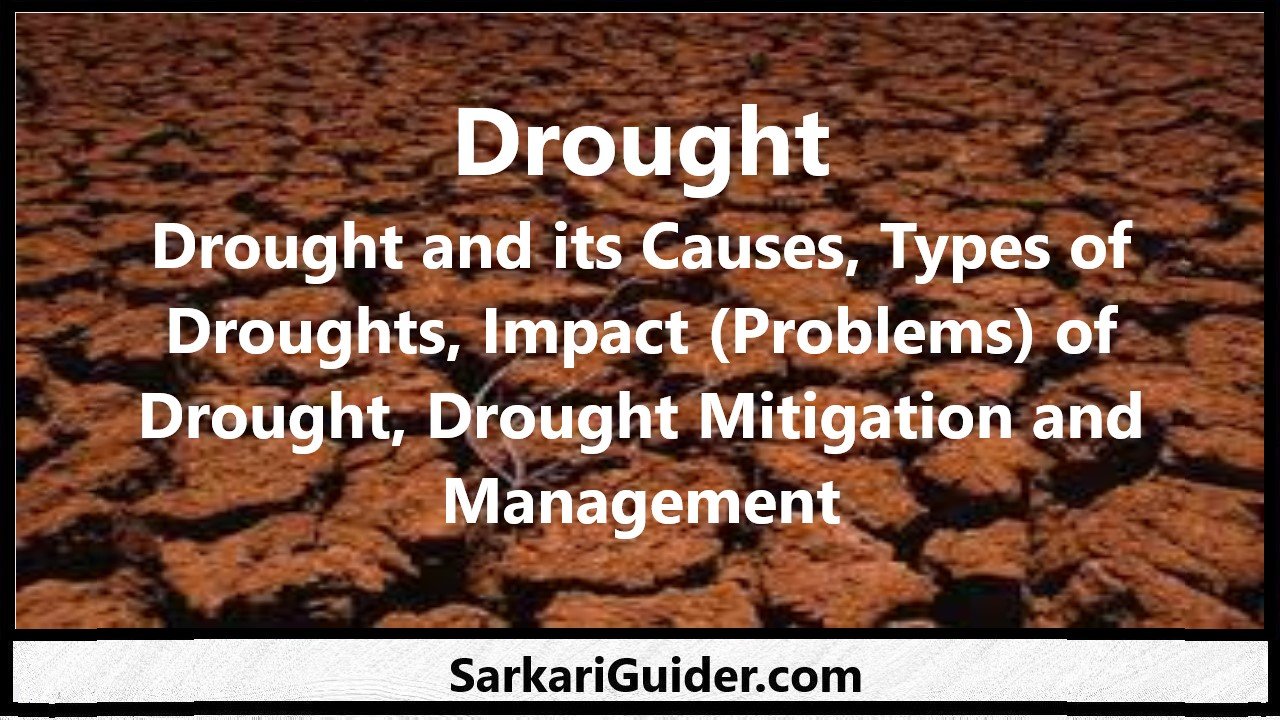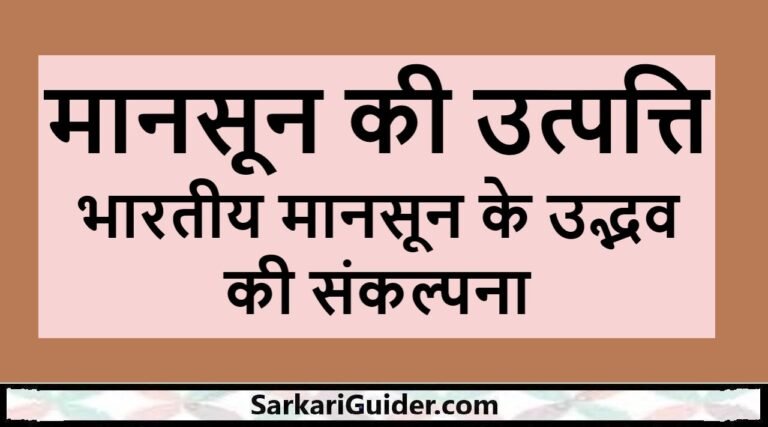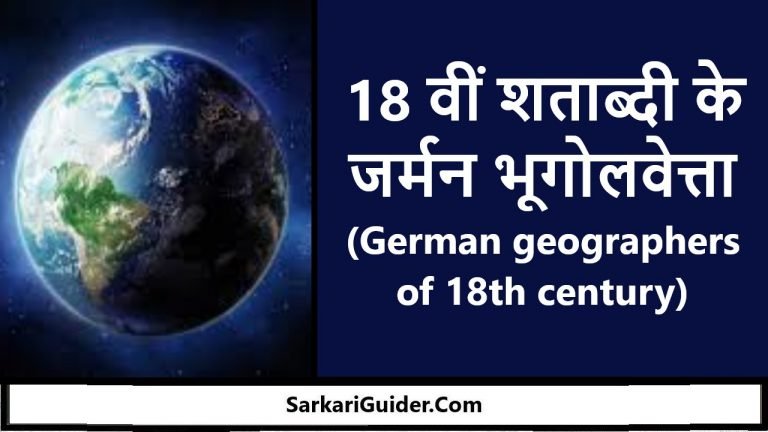Drought and its Causes, Types of Droughts, Impact (Problems) of Drought, Drought Mitigation and Management

Drought and its Causes, Types of Droughts, Impact (Problems) of Drought, Drought Mitigation and Management
Drought is also an extreme situation, which happens due to insufficiency of precipitation over a longer period causing damages to crops. Definition of drought varies in different countries and regions depending on the average precipitation level of the country such as countries or regions generally receiving lesser annual average rainfall don’t consider 5 to 6 days without rainfall as drought however similar condition is called a drought situation in countries receiving higher rainfall throughout the year.
Drought and its Causes
If flood happens due to excess of water than drought due to lack of it and dryness and resultant lack of agricultural production leads to drought situation. The major causes of drought are:
Lack of precipitation: When the level of precipitation is less than about 75% of the normal average, over a long period of time, drought happens. The drought condition is more prevalent when agricultural production gets impacted due to lack of rainfall and irrigation facilities.
Reduction of surface water flow: When the flow of surface water bodies like streams and rivers reduces or the rivers get dried up due to storage of water in dams/ reservoirs in the upstream for hydro power plants and irrigation facilities, drought like situation happen in the downstream regions of the river
Deforestation: Hydrological cycle (including evaporation, precipitation and condensation) of the earth is maintained by plants and trees. Trees have water retention capabilities, can control evaporation and maintain ground water level. Deforestation due to excessive population growth and various economic activities has exposed the surface to erosion and reduced the level of ground water and the ability of the earth surface to hold water, as a result with prolong period of dryness, desertification and drought crises appears.
Global Warming: Rise in global temperature due to increase in greenhouse gases has impacted the climate drastically as a result many areas goes dry and forest catches fires leading to desertification and drought like condition.
Types of Droughts
Droughts conditions can be classified as agricultural, meteorological, hydrological and socio economical drought. The drought condition act as indicators for government agencies, authorities and municipalities to develop a relief plan and provide related assistance to effected public.
Agricultural Drought: This drought condition impacts the country’s economy drastically. Farmers are badly effected with agricultural drought when soil moisture decreases and water demand for crop production surpasses the water supply level impacting crop growth. Decline in crop growth and production ultimately hampers the food supply and economy. Agricultural drought condition happens when the soil moisture reduces due to hot and dry weather with less rainfall leading to lack of agricultural production.
Hydrological Drought: This is a drought condition where in the water level of all the surface water bodies including dams, lakes, reservoirs, rivers etc. falls below an established standard. Even when demand or usage of water is more than the supply or availability of water in the reserves hydrological drought happens.
Meteorological Drought: This drought condition is due to natural factors like lower level of precipitation, lack of moisture in the atmosphere, dryness for longer period and high temperature. Meteorological drought if persist for longer time period can cause serious water crises and related problems. This drought can stretch from a small period to longer period.
Impact (Problems) of Drought
The impact of drought can be felt beyond the physical boundary of drought hit areas. As drought condition is associated with lack of water, it impacts not only the society but also the economy and the environment.
Economic Impact of Drought: Water is required for production of goods and service, thus lack of it impacts people, business and governments. Water is prime factor for agricultural and related field, crop production largely depends on the water supply, and hence shortage of it hampers production of both crops and livestock’s. Farmer’s or crop producers bear the brunt directly as lower crop production means direct loss of profit margin and income. Loss of income mainly of the farmer impacts their social life. Lower production and higher demand for food supply can lead to price rise of basic commodities, which have direct impact on the buyers especially the lower income group. Also, in case of shortages of basic commodities, things might be imported, again costing the government. Business might take a hitting if drought conditions persist for a long time such as most manufacturing industries, agricultural product industries, and water recreational business depends on water, so lack of it can force the business to stop operation in the affected areas. Thus many people can become jobless.
Besides, drought condition and associated dryness also increases the chances of wind erosion and birth of various diseases and epidemics as well, which costs individuals, community and the nation at large.
Lower precipitation, high temperature and dryness increases the chances of forest fires, which damages the habitat for both animal and human. Forest fire and damages to plants and other vegetation impact both public and the government. In addition, shortage of water or dryness of the surface water like rivers can impacts hydro power generation as well as transportation through waterways.
Social Impact: Drought has its direct impact on the people and the society and many indirect long term impact. For our basic daily activities including cooking, eating, bathing and cleaning we need water, thus its shortage or lack of it can directly impact our lives. Water is directly related to our health as well, we need clean and fresh water for drinking and cooking. Polluted and stale water can cause serious health implications and spread diseases across the society.
Due to lack of water supply agricultural and live stocks production takes a hitting causing lack of food production. When the supply is low the price rises impacting the poor people of the society most. Without proper watering of plants the quality of food also reduces and so does the nutritional values of the food. This lower quality food supply affects health of both human and animal and makes them vulnerable to diseases and health issues. If drought conditions persist people prefer to migrate to other places leaving their property and at times their families. Many farmers in case of agricultural droughts have to leave their farms and take up odd jobs in other areas or towns.
Water, its supply and shortages have triggered many disputes between nations, states and neighboring people. For instance, in India disputes between states regarding water is not very uncommon like Kaveri river water dispute between Karnataka and Tamil Nadu, Yamuna water usage issues between Delhi, UP and Haryana etc. these disputes causes social unrest.
Environmental Impact: Drought like conditions impact the environment drastically. If the rivers, streams and other water bodies do not get fresh water supply through precipitation or melting snow the ecosystem of such aquatic bodies can be drastically impacted. Many water borne organisms and animals dies due to lack of water supply. Lakes, Ponds and rivers, which get replenished with fresh rain water might also die if shortage of precipitations last for longer period. Soil erosion due to high temperature and dryness can remove the productive top soil leading to lower biological production and land degradations. Many animals and organisms loses their habitat threatening their extinctions.
Drought Mitigation and Management
Drought is a natural hazard that cannot be stopped from occurrence but its affects can be minimized with proper planning. Drought conditions takes time to evolve hence precautionary measures can be taken to minimize the risk of drought devastations. Predictions, observations, impact analysis and reaction are four major components of drought preparedness. Predictions about the impending climatic conditions and precipitations based on remote sensing data, satellite imageries, wind circulations etc. and proper monitoring of cloud movements, water availability and conditions of the crop are necessary steps of drought preparedness. Impact analysis of drought includes the study of crop quality, human health, state’s economy and ecosystem. The response of drought include providing relief to effected people, water storage facilities to all, water and soil conservation, more vegetation and proper planning. Following are some of the major steps to prevent drought like conditions:
- Education and Awareness: People should be educated and informed about the causes and impacts of drought in advance. Community leaders, NGO’s, schools, Colleges, government officials etc. should be trained to educate general public about ill effects of drought and steps to mitigate it. Knowledge about the problem can help the public to create their own solutions. People in the governing authority should also gain knowledge about the climatic conditions and regional landscapes so that natural disasters like drought does not take them by surprise and policies can be defined well in advance to tackle any such unwanted situation.
- Pollution Control: In case of shortage of natural water supply through precipitation and meteorological drought conditions people depend on the available water resources such as rivers, lakes, ponds etc. for clean usable water. However, if these surface water or ground water resources are polluted then problem escalates. Hence, government should ensure that the surface and ground water sources are not polluted. Even people should be educated about the problems of drought and the need for maintenance of clean water and control of pollution.
- Water and Soil conservation: Water conservation and soil conservation measures can help in limiting the devastating impacts of drought. Water conservation methods such as rainwater harvesting, surface runoff water collection, percolation ponds, proper planning of water usages, dams and reservoir construction and proper management of well and water channels limits the impact of meteorological drought conditions. Similarly through soil conservation methods soil moisture can be retained and soil erosion can also be controlled during drought period. Methods such as crop rotation, terrace farming, etc. control soil erosion and soil moisture can be retained by measures such as furrows, basins, ridges, catch pits etc., even landscape contouring where the runoff water can be directly spread in planted areas helps in increasing the soil moisture content.
These mentioned steps can control drought conditions and its disastrous effects.
महत्वपूर्ण लिंक
- भारतीय संविधान की विशेषताएँ
- जेट प्रवाह (Jet Streams)
- चट्टानों के प्रकार
- भारतीय जलवायु की प्रमुख विशेषताएँ (SALIENT FEATURES)
- राजा राममोहन राय की सम्पूर्ण जीवन यात्रा
- मृदा नमी को प्रभावित करने वाले कारक
- भूमिगत जल को प्रभावित करने वाले कारक
- परमाणु रिएक्टर का निर्माता एनरिको फर्मी
- भूमिगत जल के स्रोत
- वाष्पोत्सर्जन को प्रभावित करने वाले कारक
- मृदा नमी संरक्षण
- Important aspects related to the life of Netaji Subhash Chandra Bose
- Swami Dayanand Saraswati’s important contribution in social reform
- राजीव गांधी के व्यक्तित्व से जुड़े रोचक तथ्य
- Indian Citizenship
- अभिभावक शिक्षक संघ (PTA meeting in hindi)
- कम्प्यूटर का इतिहास (History of Computer)
- कम्प्यूटर की पीढ़ियाँ (Generations of Computer)
- कम्प्यूटर्स के प्रकार (Types of Computers )
- अमेरिका की क्रांति
- माया सभ्यता
- हरित क्रान्ति क्या है?
- हरित क्रान्ति की उपलब्धियां एवं विशेषताएं
- हरित क्रांति के दोष अथवा समस्याएं
- द्वितीय हरित क्रांति
- भारत की प्रमुख भाषाएँ और भाषा प्रदेश
- वनों के लाभ (Advantages of Forests)
- श्वेत क्रान्ति (White Revolution)
- ऊर्जा संकट
- प्रमुख गवर्नर जनरल एवं वायसराय के कार्यकाल की घटनाएँ
- INTRODUCTION TO COMMERCIAL ORGANISATIONS
- Parasitic Protozoa and Human Disease
- गतिक संतुलन संकल्पना Dynamic Equilibrium concept
- भूमण्डलीय ऊष्मन( Global Warming)|भूमंडलीय ऊष्मन द्वारा उत्पन्न समस्याएँ|भूमंडलीय ऊष्मन के कारक
- भूमंडलीकरण (वैश्वीकरण)
- मानव अधिवास तंत्र
- इंग्लॅण्ड की क्रांति
- प्राचीन भारतीय राजनीति की प्रमुख विशेषताएँ
- प्रथम अध्याय – प्रस्तावना
- द्वितीय अध्याय – प्रयागराज की भौगोलिक तथा सामाजिक स्थित
- तृतीय अध्याय – प्रयागराज के सांस्कृतिक विकास का कुम्भ मेल से संबंध
- चतुर्थ अध्याय – कुम्भ की ऐतिहासिक एवं सांस्कृतिक पृष्ठभूमि
- पंचम अध्याय – गंगा नदी का पर्यावरणीय प्रवाह और कुम्भ मेले के बीच का सम्बंध
Disclaimer: sarkariguider.com केवल शिक्षा के उद्देश्य और शिक्षा क्षेत्र के लिए बनाई गयी है | हम सिर्फ Internet पर पहले से उपलब्ध Link और Material provide करते है| यदि किसी भी तरह यह कानून का उल्लंघन करता है या कोई समस्या है तो Please हमे Mail करे- sarkariguider@gmail.com







